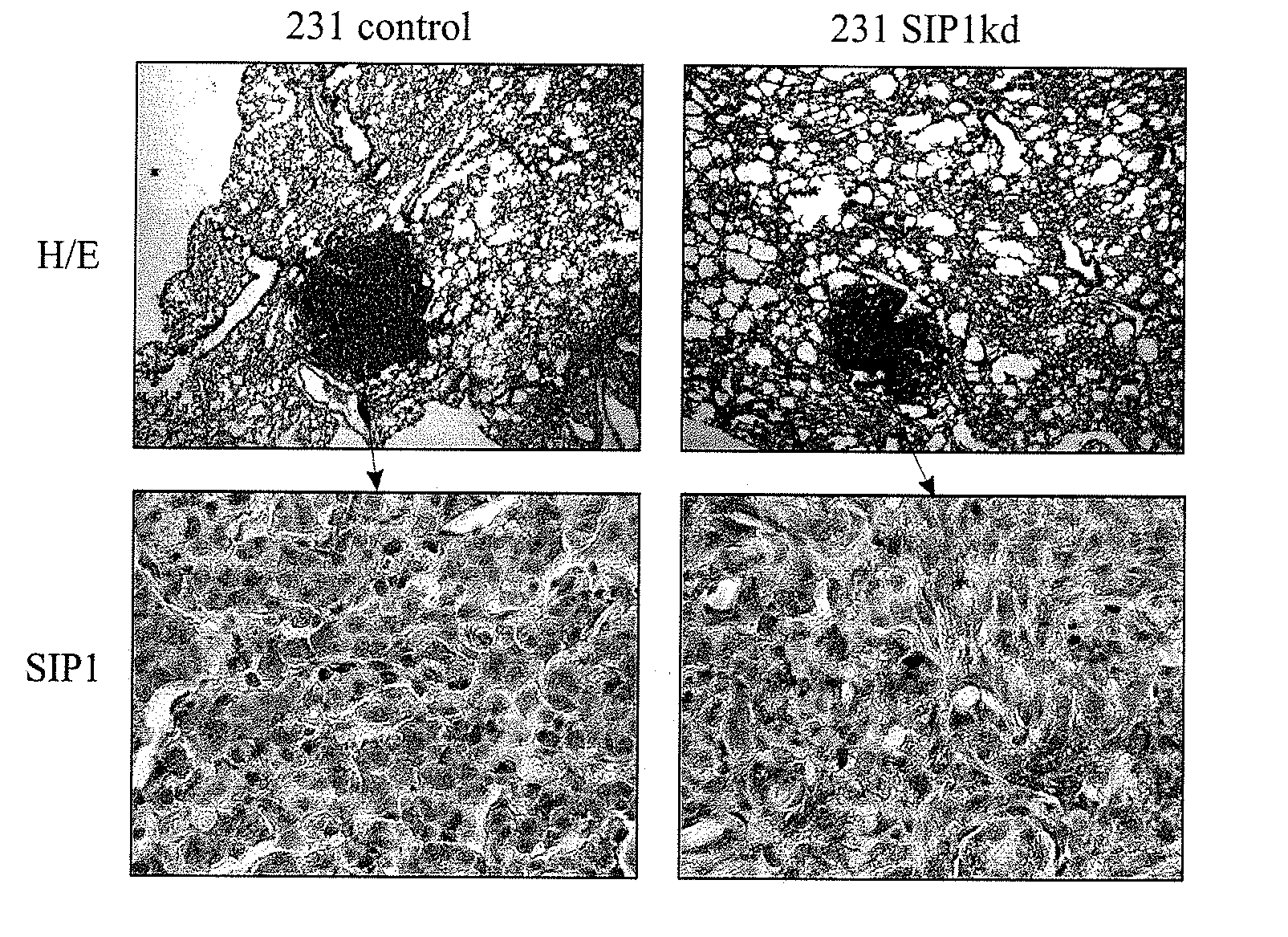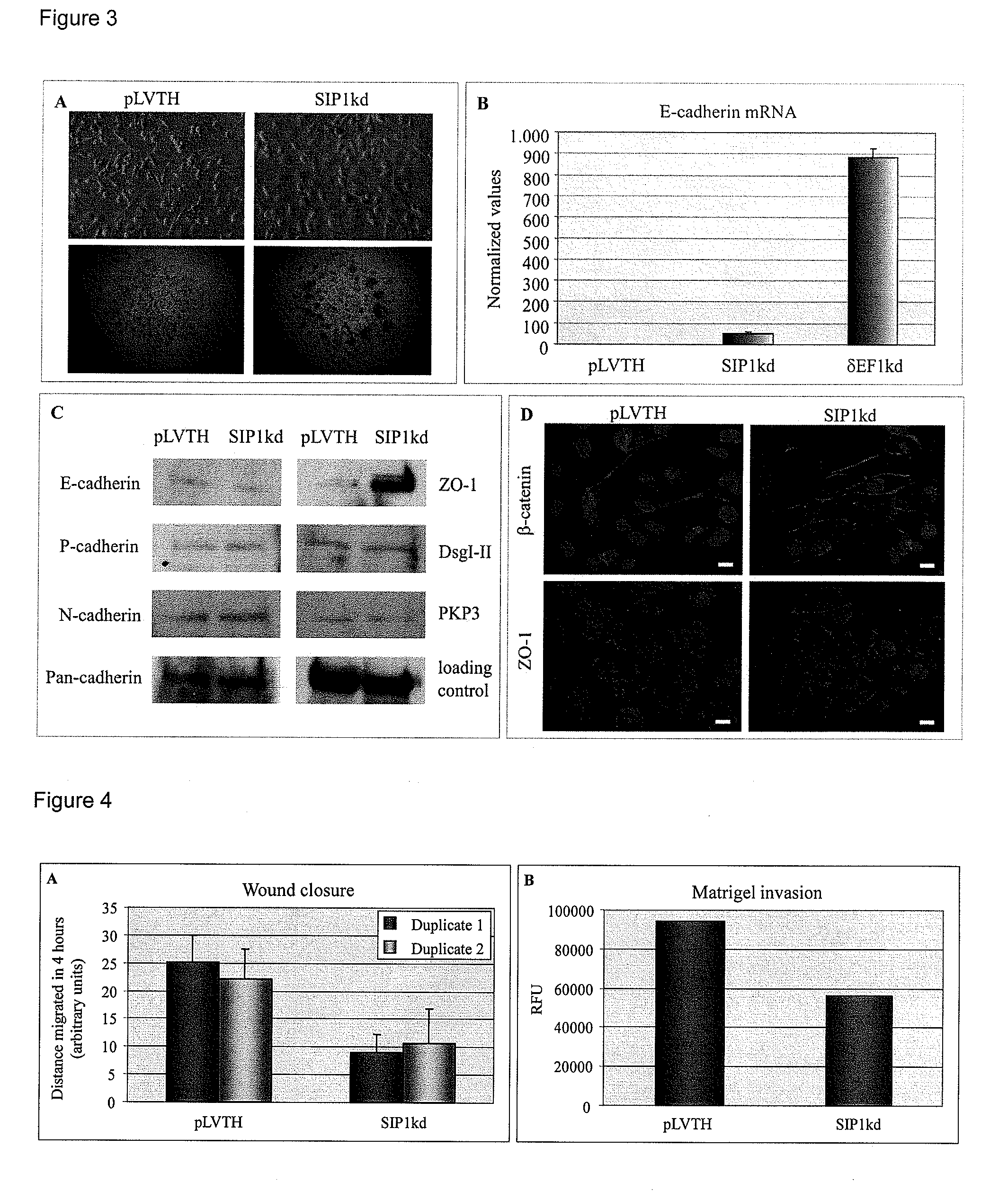Use of sip1 as determinant of breast cancer stemness
a breast cancer stemness and sip1 technology, applied in the field of sip1, can solve the problems of limiting tumor development and repression of metastasis, and achieve the effects of reducing survival, rapid tumor progression, and high sip1 expression
- Summary
- Abstract
- Description
- Claims
- Application Information
AI Technical Summary
Benefits of technology
Problems solved by technology
Method used
Image
Examples
example 1
MDAMB231 Expresses an Array of EMT-Inducing Transcription Factors
[0052]As mentioned, MDAMB231 breast cancer cells show many features of mesenchymal cells including loss of E-cadherin expression. As E-cadherin down-regulation is often enforced by the action of transcriptional repressors, we examined the expression status of the E-cadherin repressors ZEB1 / δEF1, ZEB2 / SIP1, Slug, Snail and Twist in MDAMB231 by quantitative RT-PCR. ZEB1 / δEF1 shows the highest expression level, followed by Slug while ZEB2 / SIP1 and Snail are only moderately expressed (FIG. 1). The cells were negative for Twist expression.
[0053]Selective knock-down of ZEB1 / δEF1 in MDAMB231 leads to re-acquired epithelial-specific features concomitant with re-expression of E-cadherin and other epithelial-specific proteins (Aigner et al., 2007). We wanted to investigate whether the moderate ZEB2 / SIP1 expression in this cell line has a functional contribution to the dedifferentiated state of these cells. We therefore created a...
example 2
Reduced ZEB2 / SIP1 Expression Leads to Enhanced Cell-Cell Adhesion
[0054]A lentiviral vector (pLVTH) (Wiznerowicz and Trono, 2003) containing a short hairpin RNA sequence designed to specifically target ZEB2 / SIP1 mRNA, was stably transduced in MDAMB231, as was the empty vector. Quantitative RT-PCR showed a ±90% reduction of ZEB2 / SIP1 mRNA expression in the knock-down cells (SIP1kd) as compared to the empty vector-transduced control cells (pLVTH). No down-regulation of the expression level of the closely related family member of ZEB2 / SIP1, ZEB1 / δEF1 could be detected (FIG. 2, Panel A). This is concomitant with the low sequence similarity of the 3′UTR sequences of ZEB2 / SIP1 and ZEB1 / δEF1 to which the ZEB2 / SIP1 siRNA is targeted (FIG. 2, Panel B).
[0055]As MDAMB231 SIP1kd cells showed a less pronounced mesenchymal morphology and exhibited closer contacts with their neighboring cells, as compared to the pLVTH control cells (FIG. 3, Panel A), we examined whether the ZEB2 / SIP1 knock-down has...
example 3
ZEB2 / SIP1 Contributes to Tumor Cell Migration and Invasion In Vitro
[0058]MDAMB231 cells are highly motile and to investigate the effect of ZEB2 / SIP1 depletion on directional cell migration, we performed in vitro wound closure assays. In a time period of four hours, the SIP1kd-transduced cells had only migrated half the distance of the pLVTH-transduced cells (FIG. 4, Panel A). Knock-down of ZEB2 / SIP1 thus impairs in vitro cell migration. These data are in agreement with the results obtained in another breast cell line, MCF10A, in which reduced ZEB2 / SIP1 expression coincides with down-regulated vimentin expression and diminished migratory capacities (Bindels et al., 2006).
[0059]We next performed matrigel invasion assays to determine whether ZEB2 / SIP1 knock-down also affects the in vitro invasive behavior of the MDAMB231 cells. Both pLVTH-transduced and SIP1kd-transduced cells were seeded in serum-free conditions on top of matrigel-coated transwell filters and allowed to migrate toward...
PUM
 Login to View More
Login to View More Abstract
Description
Claims
Application Information
 Login to View More
Login to View More - R&D
- Intellectual Property
- Life Sciences
- Materials
- Tech Scout
- Unparalleled Data Quality
- Higher Quality Content
- 60% Fewer Hallucinations
Browse by: Latest US Patents, China's latest patents, Technical Efficacy Thesaurus, Application Domain, Technology Topic, Popular Technical Reports.
© 2025 PatSnap. All rights reserved.Legal|Privacy policy|Modern Slavery Act Transparency Statement|Sitemap|About US| Contact US: help@patsnap.com



